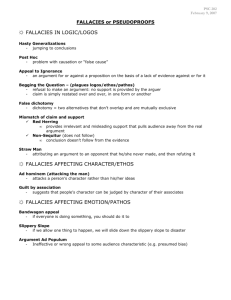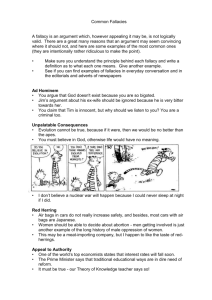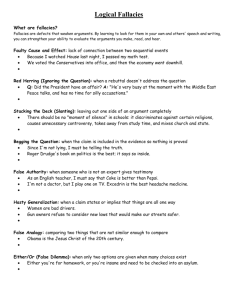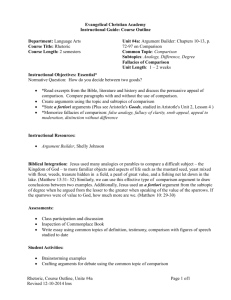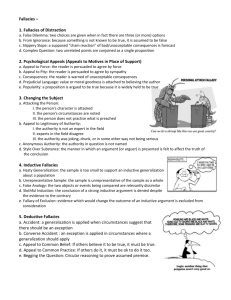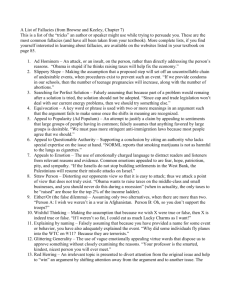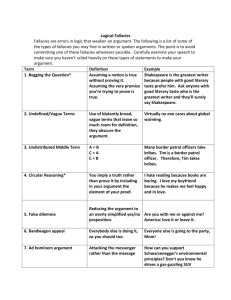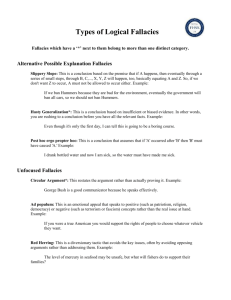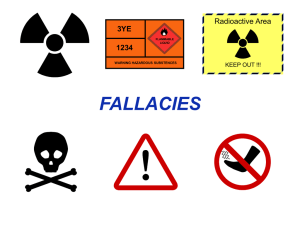Fallacies
advertisement
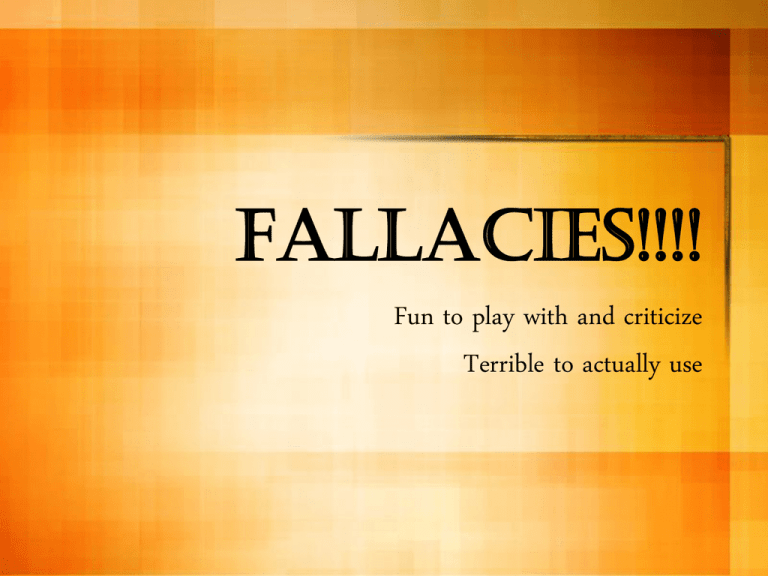
Fallacies!!!! Fun to play with and criticize Terrible to actually use What is a fallacy? A false or mistaken idea; an often plausible argument using false or invalid inferences Qualities of Fallacies Sometimes very persuasive Hard to identify Weaken an argument Why is knowing about fallacies important? Knowing about them will make them easier to pinpoint in your work as well as in others’ works – You automatically have the upper hand in a discussion if you can provide strong evidence as well as be free from fallacies 4 Categories Relations to others Attacks on an individual Poor and False Logical Development Extras… Relations to Groups Appeal to Authority/Testimonial: – Using a culture icon or someone with “authority” on the subject as “evidence” for your argument HP Computers Appeal to Popularity/Bandwagon: – “Everyone’s doing it” - fear of rejection if you don’t join in… “Four out of five dentists surveyed preferred Crest toothpaste over the other leading brands.” Advertisers who urge consumers to buy “the brand that's number one” are using bandwagon appeal. – Numbers may not exactly be true or skewed to appeal to the consumer. – “Many people…” - general claim! Attacks on the Individual Ad Hominem/Personal Attack: – Making a personal attack on the individual instead of arguing for themselves. See this a lot in political ad campaigns Mac vs. PC Windows Vista Guilt by Association: – Assuming someone or something is not worth buying/trusting because he/she/it is associated with a certain group of people McCarthyism was a specific version of Guilt by Association in which an individual, organization, or idea was associated in some way with communism (civil rights supporter, etc.) Poor and False Logical Development Post hoc ergo propter hoc/False Cause: – Assuming. Since Event B followed Event A, then A must have caused B. Statistics show that at beaches this past summer, ice cream sales have gone up. So has the number of people drowning in the ocean. Ice cream must be the culprit. FRIENDS example Limited Options/Either-Or: – Assuming there are only two sides to an argument or offering only two choices “Either friend.” she comes to my party or she’s not my real Non sequitur/It does not follow: – A statement that does not follow logically or is not clearly related to anything previously said. “Tens of thousands of Americans have seen lights in the night sky which they could not identify. The existence of life on other planets is fast becoming certainty!" False Analogy/Comparison: – Using analogies often make poor evidence because the two things are not alike in all aspects - the assumption is that two things are more alike than they really are. Rolling socks makes you feel younger?!?! Extras… Begging the Question/Circular Reasoning: When the given argument depends on what it is trying to support, and as a result, the argument in question is being used to prove itself. – “Why did he do that? Did he have a reason?” “Of course he had a reason, or he wouldn’t have done it.” Loaded Question: Asking a question that assumes something that has not been proven yet - forces an answer based on false or controversial premises. – “Do you know how fast you were going?” Answer yes: admit to speeding Answer no: admit not paying attention/speeding Who Can Write the Worst Ad? In groups, decide on a product. This could be something we all know about, something made up, or even a person (think of political ads or “changed” celebrities) Must tell us: What the product is. Why we should all have/believe this product. Create a visual ad. (Magazine spread? Billboard?) Create a small speech for this product. This speech must be LOADED with fallacies. At least 3 You will present your products to the class. Be creative and have fun!
